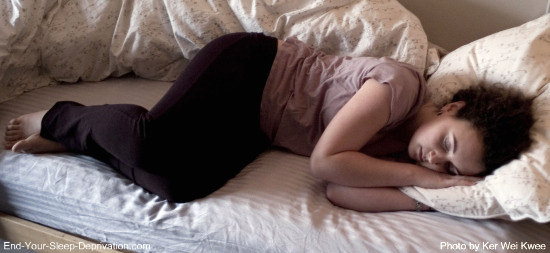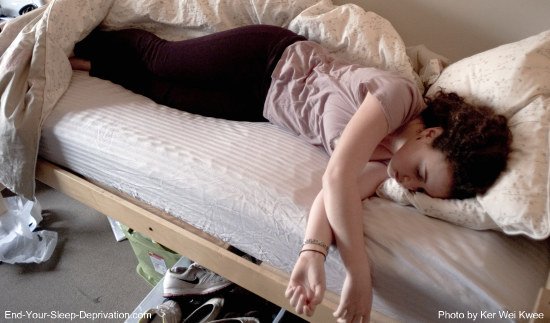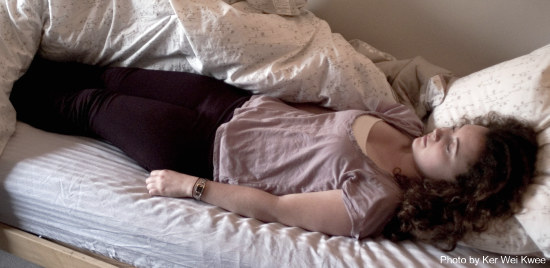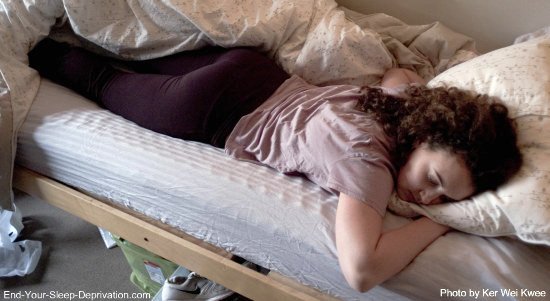
| Connect & Subscribe |
The Significance of Sleeping Positions?
Many of us habitually have our favorite sleeping positions. You can probably think of yours right now. But do you know what it's called? Is it the Log? The Yearner? The Freefall? In this article, we will discuss what is said about the meanings of these various sleeping positions and others, as well as their possible health effects.
In research conducted by Professor Chris Idzikowski, director of the UK Sleep Assessment and Advisory Service, it was found that each of the typical sleeping positions are somewhat correlated to a particular personality type. His research also found that most people are unlikely to change their sleeping position too much from day to day. Just 5% of those queried said that they sleep in a different position every night.
While there's all sorts of generalized and nonsensical conclusions that can be drawn from questions like "what your sleeping position says about you," it is a bit intriguing that Dr. Idzikowski found a significant correlation in a scientific manner, and in a survey of a rather large pool of people (1,000 participants). Perhaps the way we sleep reflects a bit of the subconscious body language we carry around with ourselves throughout the day (and apparently the night).
How do you sleep at night? Share your favorite sleeping position with us and see what others have to say about theirs.
Let's take a look at the correlations he found. The positions are listed in order of the frequency they occured in Dr. Idzikowski's study.
Foetus (or Thinker) - 41%
Position: The Foetus position, otherwise known as the Thinker position, is characterized by sleeping on one's side, in a curled up position. Arms are curled on top of the pillow, or occasionally one arm will be under the pillow. The hands can be in a variety of positions, but Foetus positions are always characterized by at least one hand resting near the chin.

Personality: Adopters of the foetus position are perceived to be tough on the outside but sensitive on the inside. They may be shy when they first meet somebody, but soon relax. This is the most common sleeping position--adopted by some 41% of the 1,000 people who took part in Professor Idzikowski's survey. More than twice as many women as men tend to adopt this position.
Health Effects: It is recommended that when lying on your side in the fetal position with your knees bent, you have a pillow tucked between your legs to take as much stress as possible off your back. Use a full-length body pillow if you prefer. This position may be particularly helpful if you have osteoarthritis in the spine, spinal stenosis--a narrowing in the spine--or hip pains.
Log - 15%
Position: This one's pretty straightforward: Log sleepers sleep on their sides with their back and legs straight, both hands down by their sides, and their cheek resting against the pillow--straight like a log.

Personality: Log sleepers tended to be easy-going, social people who like being part of the in-crowd. They are trusting of strangers, and they may even be gullible.
Health: Sleeping with one's side on one's hand causes the head and neck to be awkwardly positioned. Hence, Log sleepers generally have a difficult time finding a pillow that provides them adequate head and neck support while simultaneously remaining soft and comfortable for the side of their face to rest upon.
Yearner - 13%
Position: The Yearner position is where one sleeps with his or her head slightly off the centre of the pillow, arms outstretched along the pillow, back straight, and legs slightly bent.

Personality: People who sleep on their side with both arms out in front are said to have an open nature, but can be suspicious and cynical. They are slow to make up their minds, but once they have made a decision, they are unlikely to change it.
Health: Yearners may have trouble finding a good pillow because most pillows are not designed to support the head and neck evenly throughout the pillow.
Soldier - 8%
Position: A Soldier sleeps flat on his or her back, face to the ceiling, (with both arms pinned down at the side or slightly out, and legs straight.

Personality: People who sleep in this position are generally quiet and reserved. They don't like a fuss, but set themselves and others high standards.
Health: Soldiers should have firm support for the back of the head and neck. Soldier sleepers can have difficulty deciding between soft and firm pillows because both have their advantages for this sleeping position: the softer pillows provide a more comfortable support for the neck, while a firmer pillow tends to feel more comfortable on the back of the head. Professor Idzikowski concluded that soldier were more likely to lead to snoring and a bad night's sleep.
Freefall - 7%
Position: A Freefall sleeper lies on his front with his hands wrapped around the pillow, and his head turned to one side.

Personality: Freefallers are often gregarious and brash people, but they can be nervy and thin-skinned underneath. They don't like criticism, or extreme situations.
Health: It is recommended that you do not sleep on your abdomen. Sleeping facedown can exaggerate the arch at the base of your spine and cause strain. If you can't sleep comfortably any other way, you should reduce the strain on your back by placing a pillow under your pelvis and lower abdomen. Use a pillow under your head if it doesn't place too much strain on your back. If not, try sleeping without a pillow under your head. It is challenging to find just the right pillow firmness for Freefallers. However, this position may be helpful if you have degenerative disease or a herniated disk in the central portion of your spine.
Starfish - 5%
Position: The Starfish position is where one sleeps on his back and spreads both his arms and legs out in a five-pointed ÒstarfishÓ position.

Personality: Starfish sleepers make good friends not only because they are always ready to listen to others but also offer help when needed. They generally don't like to be the centre of attention.
Health: The Starfish position can be bad for your back. If you must sleep on your back, prop a big, fluffy pillow under your knees to maintain the normal curvature and reduce the pressure on the sciatic nerve in your lower back. A small, rolled towel under the small of your back may be helpful to provide additional support. You may support your neck with a pillow. Like the Solider position, Professor Idzikowski concluded that starfish was more likely to lead to snoring and a bad night's sleep.
And join the conversation with your own comments here:
blog comments powered by DisqusWhat Are Your Favorite Sleeping Positions?
Which sleeping positions do you prefer? Maybe that thought hasn't even crossed your mind before. Think about it, and tell us how you prefer to hit the hay.
Read More Thoughts On Sleeping Positions
Click on the links below to read other thoughts regarding on people's favorite sleeping positions. They were all contributed by visitors to this page, just like yourself.
Part Foetus, Part Soldier, All With A Starfish Attitude
I always find it really disconcerting that I seem to be the only human being that sleeps this way: on my front, lying on one arm (placed in my hip so as …
Body Language When I Sleep-I Rotate Through All Sleeping Positions
I have noticed that when I first lie down to sleep, I am on my back with my hands folded over my chest. At times though, I find that I will extend my …
I am *Mostly* a Foetus
I tend to fall asleep in the Foetus position , but sometimes feel more comfortable with outstretched arms, less bent legs, edge of pillow as the Yearner. …
Freefall?
I sleep on my front but with a leg pulled up to my chest, knee close to my breast. One arm up by my head and the other either down by my side or under …
I Sleep On My Back With My Knees Bent
This position enables me to sleep very deep,to me it is very relaxing, but my husband thinks it is weird to sleep on ones back with the knees bent facing …
I Can't Fall Asleep In Normal Sleep Positions
When I'm asleep, I tend to rotate through three positions throughout the night (Foetus, Yearner, and Starfish), but I can't actually FALL ASLEEP in any …
Sitting Up Sleeping Is More Comfortable For 5 Yr Old
My 5 yr old sleeps laying down but always wakes up through out the night and sits up.. and will sleep throughout the night if i allow her to sit up.. I …
About This Site
Welcome! This site is continuously being created by students of Dr. William C. Dement's Sleep And Dreams course at Stanford University.
We made this site as a call to action for people all over the world to live healthier, happier, safer, and more productive lives by learning about their own sleep. We have faith that reading the information provided on this site will motivate you to be smart about your sleep deprivation and strategic about your alertness in order to live life to your fullest, most energetic potential.
In fact, we challenge you to do so! What do you say, are you up for the challenge?
Interviews With Sleep Specialists: Insights Into the Worlds of Sleep Medicine & Sleep Business
America's Most Dangerous Disorder: What Is Sleep Apnea Doing To Your Sleep?
Sleep Debt: How Much More Will You Achieve When You Reduce Yours?
The Stages Of Sleep: The Journey Through The Night
Delayed Sleep Phase: You Want To Sleep But You're Not Tired Yet
Paralyzed at Night: Is Sleep Paralysis Normal?
Sleep In Words: Smart, Strange, and Funny Quotes About Sleep
Sleep Disorders In Children: What's Keeping Your Child From A Full Night's Rest?
Attacks of Pavor Nocturnus (a.k.a. Sleep Terrors, Night Terrors, or Incubus Attacks)
The Stanford Sleep Book
Dr. Dement's pioneering textbook has been the core text for Sleep and Dreams since 1980, but it has just recently been made available to the wider public for the first time.
In it you'll find a more detailed account of the most important things you need to know about sleep, alertness, dreams, and sleep disorders. Studies, statistics, plus plenty of Dr. Dement's classic anecdotes painting the history of sleep medicine.
Preface | Intro | Contents | Get A Copy
More Sleep Resources
The Zeo
A revolution in personal sleep tracking, the Zeo is a wireless headband that transmits your brainwaves in realtime to a dock (pictured here) or your smartphone. The result? You can wake up and see exactly what stages of sleep you were in during the night! Unprecedented personalized sleep knowledge.
Sleep Paralysis: A Dreamer's Guide
Ever woken up paralyzed? A surprising number of us have, believe it or not. But few know the actual causes of this phenomenon, and fewer still how to exert control over it. Dream researcher and sleep paralysis expert Ryan Hurd shares breakthrough insights into how to do just that.
Important Disclaimer
Please Note:
The information found on this page and throughout this site is intended for general information purposes only. While it may prove useful and empowering, it is NOT intended as a substitute for the expertise and judgments of healthcare practitioners.
For more info, see our
Terms of Use.









